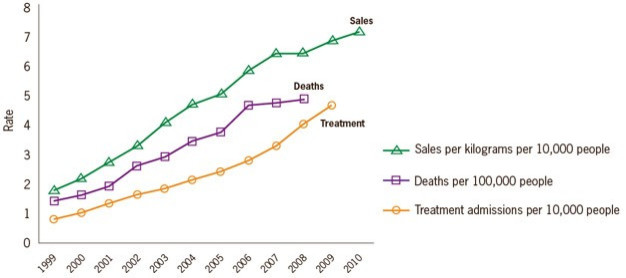Prescription Painkiller Overdoses Cost Insurers $72.5 Billion Yearly: CDC

Nearly 15,000 people in the U.S. die yearly from overdoses involving prescription painkillers, the Centers for Disease Control and Prevention reports.
Unauthorized use of prescription painkillers costs health insurers up to $72.5 billion annually in direct health care costs. To counter this problem, the government is urging health insurers to increase coverage for other treatments to reduce pain, such as physical therapy, and look out for specific treatments for substance abuse rather than prescribing painkillers as the first line of treatment.
The CDC reported that overdoses from prescription painkillers have so risen in the past decade as to exceed the combined toll from heroin and cocaine abuse.
Such painkillers are meant to help people who have severe pain, said Dr. Thomas Frieden, director of the CDC. He added, They are, however, highly addictive, as reported by the Associated Press.
The CDC said that overdoses involving prescription drug class such as hydrocodone, methadone, oxycodone, and oxymorphone have now reached epidemic proportions in the U.S. These drugs are widely misused and abused such that in 2010 alone, one in 20 people in the United States, ages 12 and older, used prescription painkillers without a prescription or just for the high they caused.
A recent CDC analysis discussed this growing epidemic and suggested measures for prevention. The CDC data highlights state-wise overdose of prescription painkiller noting that sales per person were more than three times higher in Florida, which has the highest rate, than in Illinois, which has the lowest.
States with higher sales per person and more nonmedical use of prescription painkillers tend to have more deaths from drug overdoses. During 2008-2009, unauthorized use of painkillers in the past year ranged from 1 in 12 people (age 12 or older) in Oklahoma to 1 in 30 in Nebraska.
The CDC data states that in 2010, about 12 million Americans (age 12 or older) reported nonmedical use of prescription painkillers in the past year. Nearly half a million emergency department visits in 2009 were due to people misusing or abusing prescription painkillers. The data also said that prescription painkiller overdoses killed nearly 15,000 people in the U.S. in 2008. This is more than three times of the 4,000 people killed by these drugs in 1999.
Overall, 36,450 fatal overdoses occurred in 2008, including accidental cases and suicides involving illegal drugs such as heroin and cocaine along with prescription medicines. About three-quarters of the deaths from prescriptions involved narcotic painkillers.
The CDC report stated that more men than women die of overdoses from prescription painkillers and that middle-aged adults have the highest prescription painkiller overdose rates. Also, rural counties are nearly twice as likely to overdose on prescription painkillers than people in big cities. Whites and American Indian or Alaska Natives are more likely to overdose on prescription painkillers. About 1 in 10 American Indian or Alaska Natives aged 12 or older used prescription painkillers for nonmedical reasons in the past year, compared to 1 in 20 whites and 1 in 30 blacks.
In its report, the CDC has prescribed guidelines for healthcare providers to minimize abuse of these drugs. Some are highlighted as below:
Screen and monitor for substance abuse and mental health problems.
Prescribe painkillers only when other treatments have not been effective for pain.
Prescribe only the quantity of painkillers needed based on the expected length of pain.
Use patient-provider agreements combined with urine drug tests for people using prescription painkillers in the long run.
Talk with patients about safely; using, storing and disposing of prescription painkillers.
© Copyright IBTimes 2024. All rights reserved.





















